A while back, I wrote an article on ‘Recording Feed from FOH‘ about how to overcome the differences in volume between the ‘music’ portion and the ‘spoken’ portion of a service. However, this was much before all churches would pivot and turn to online services. Having better stream audio is something we can all be working toward, as the online service is always a great stepping stone for church seekers and is often the first place people look when moving into town. No matter if you have a broadcast console or run everything from FOH, I’ll lay out a few tips for improving streaming audio for your church or venue.
Broadcast vs. Front of House Console
A broadcast console is dedicated to mixing the online stream, whereas a Front of House console is dedicated to mixing the worship service in-room. If you have the budget and staffing to allow for a broadcast console, it is one of the best ways to improve your online stream. Having an audio engineer mixing for your online service allows them to be very strategic with the choices they are making for that specific audience.
The reality is that it isn’t often realistic for churches to have the budget or staffing for a broadcast console. Most will have the one mixer sitting back at the FOH booth feeding the main PA, monitors, and the online stream. You can have a great online mix with this setup, it is just a little more work to get there.
Overcoming Volume of Music vs. Speech
In my article on ‘Recording Feed from FOH‘, I explained how the worship volume at most churches is going to be around +10-20 dB louder than the speech portions of their service. This volume difference means that your pastor will be around 10-20 dB quieter than your music. For online, this can be a big issue but in the room, it’s necessary.
To overcome this volume difference and improve your stream audio, we have to utilize the busses inside of the console to give the pastor/speaking microphones a boost.
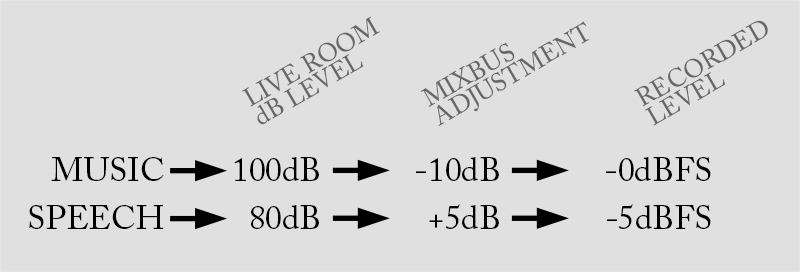
There are a few ways to do this, but I prefer one method in particular. I recommend setting up a ‘stream’ mixbus, where we can pair two mixbusses to create a Left Right mix specifically for online. When setting this up, I recommend putting it as Post Fader so that your mix will carry through to the stream mix. Next, you will want to put all of your band sends to this mixbus at -10 dB and any speaking/pastor/host microphones at +5 dB.
Here’s an optional step that I like to include when I’m planning for online church services. As you are mixing in room, and everything sounds great, take the time to check your online stream audio. If you notice there isn’t enough drums in the online mix but it is perfect in room, go back and then bump up your mixbus sends on the drums from -10 dB to -8 dB. Do this for any instruments that you can’t hear well enough in the online mix, but are hearing perfectly fine in the room. After a few times back and forth, you will find that your online mix will sound just like your in room mix.
To recap, here are those steps:
- Create a Post Fader Pair of Mixbusses.
- Set the ‘band & vocal’ channels at -10dB send to the mixbusses.
- Set any talking/speaking/host/pastor mics at +5dB send to the mixbusses.
- (optional) Adjust the send to the mixbusses after creating a balanced mix in room and then comparing the stream mix from the in-room mix.
Overcoming Low Stream Volume
One common problem churches face when using their FOH console for stream audio is that their online stream volume is too low. This happens when the PA volume is turned up too high, which in turn makes the sound board levels very low.

Turning down the volume of the PA allows you to raise your board levels to a consistent volume of ‘unity gain’. Having your output meters in the -18dBFS level will massively help your streaming audio levels, but one more method is to use a mastering limiter.
Precision Limiter for Better Stream Audio

The Precision Limiter is an insertable effect inside of the Behringer X32 effects rack. I will often recommend inserting this on your stream audio buss to maximize the loudness of your audio. We can measure the loudness of our audio using a measurement called LUFS.
First, more on LUFS
LUFS is a loudness measurement and it stands for ‘Loudness Units Relative to Full Scale’. This is similar to our dBFS that we see on the meters of the Behringer X32 and Midas M32, however this measures the overall loudness, or average volume, of the audio.
Online streaming should have levels which are around -16 LUFS for streaming sites like YouTube or Facebook to have a sufficient volume level for the end user. This makes a consistent volume experience for the end user between watching ads on the streaming platform, other videos, and your live stream.
A great tool for measuring LUFS is the Waves WLM Loudness Meter.
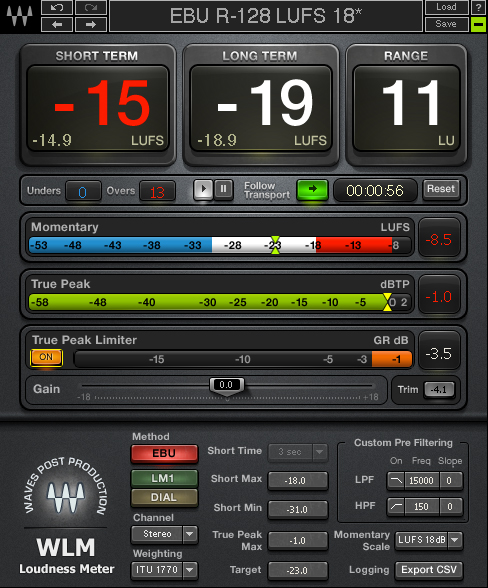
This Waves plugin is an inexpensive way to measure the LUFS of your audio signal, and if you are using a streaming program like OBS, you can insert this as an audio effect. Or you can record your stream audio using a DAW, and then measure the LUFS at a later time.
If you are thinking of purchasing anything from Waves, click through this link for 10% off on new Waves Plugins & Bundles!
Precision Limiter Effect Tutorial
The Precision Limiter will allow you to boost the overall loudness (LUFS) of your stream audio and reduce the likelihood of clipping your audio. To use this, you will want to insert this on your stream outputs.
Starting Settings:
- Input Gain: +5dB (adjust to taste)
- Stereo Link: OFF
- Out Gain: -0.5dB
- Auto Gain: OFF
- Squeeze: 40%
- Knee: 2dB
- Start with a medium attack time (around 0.15-0.2ms) and adjust to taste.
- Start with a faster release time (around 60-96ms) and adjust to taste.
The more we increase the input gain, the more loudness we will add. However if you add too much, you will find that your mix will feel squashed or over-compressed. Be careful with this adjustment! If you want to dive deeper on the Precision Limiter, read through my recent article here.

How Loud is Your Mix?
The next time you are mixing, grab a SPL meter and see what dB level you are mixing at.
There are some fascinating studies on how the human ear perceives the audio spectrum called the Equal-Loudness Contour or the Fletcher-Munson Curve. These studies show the frequency response of the human ear at different volume levels. It was discovered that human hearing is more sensitive to certain parts of the audio spectrum and that those levels of sensitivity change as volume is increased or decreased.
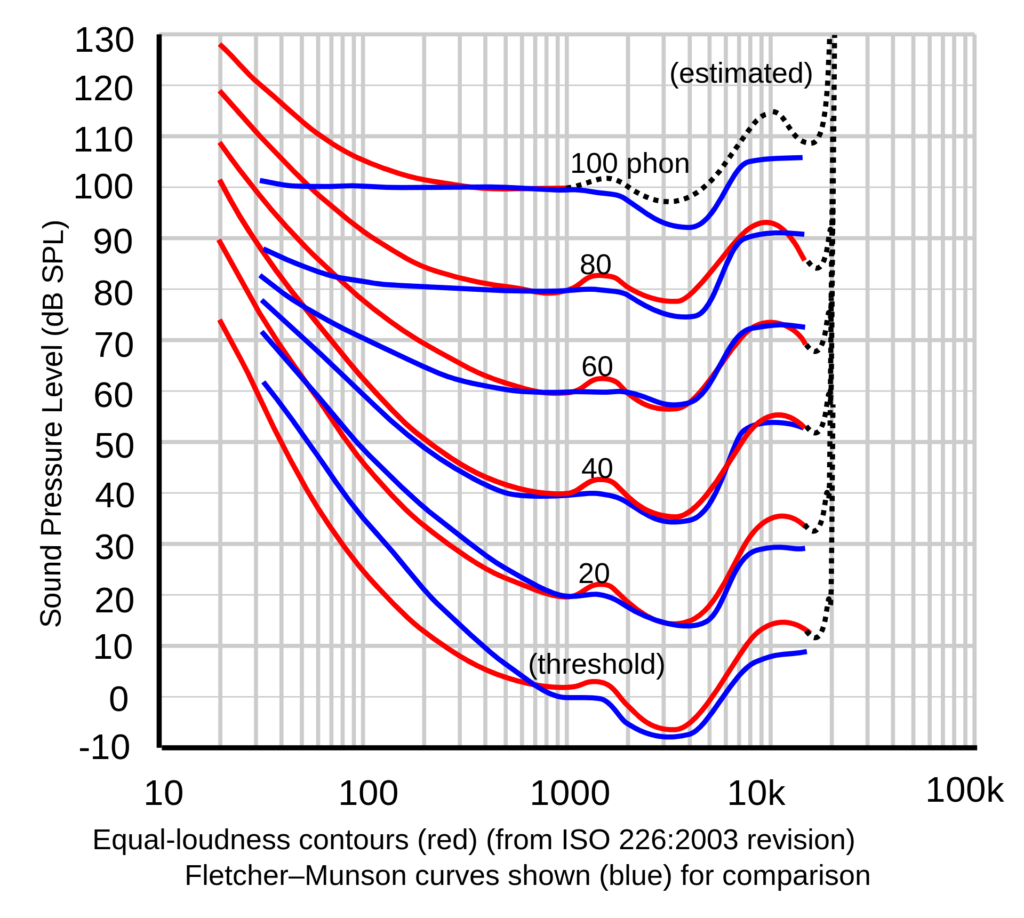
At the most basic level, the study of equal-loudness compares 1kHz tone at a set dB level. For this example, we will set that 1kHz tone at 90dB, this is equal to 90 Phon (1 Phon = 1kHz tone at 1 dB). The Equal-Loudness will then compare other tones throughout the audio spectrum and at what dB level those appear to be equal-loudness to the user.
You can see that as the volume is changed, the curve changes. This is where we can see that when we listen to a mix louder, the bass seems more full, than if we turn it down quieter.
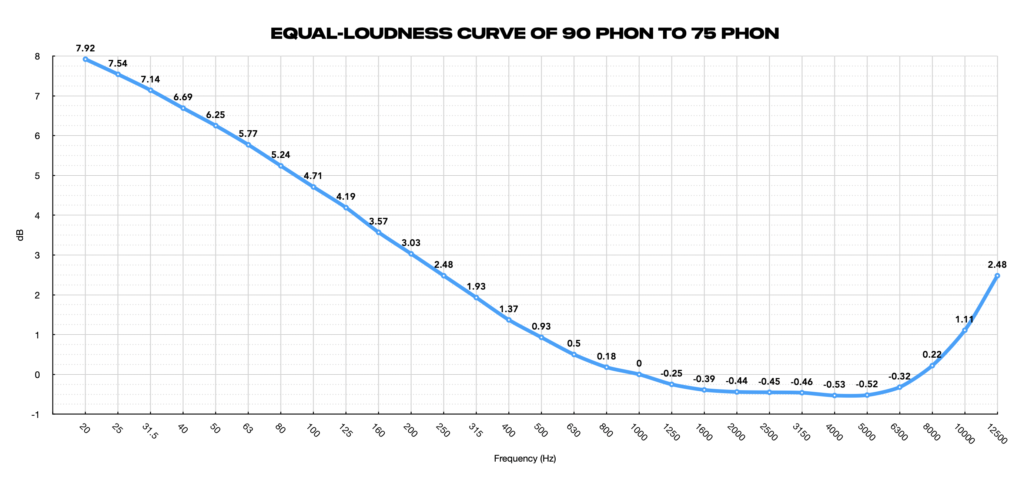
This is where I extrapolate data! Here is a 90 Phon listened to at 75 Phon. This is going to represent most churches out there, 90dB in room, and most end viewers are going to watch your service online around 75dB.
Based on this, we need to apply an EQ curve to our FOH mix if we are mixing at 90dB and want our audience to experience a similar mix at home when they are listening to the same content on a quieter level.
EQ Curve for Stream Output
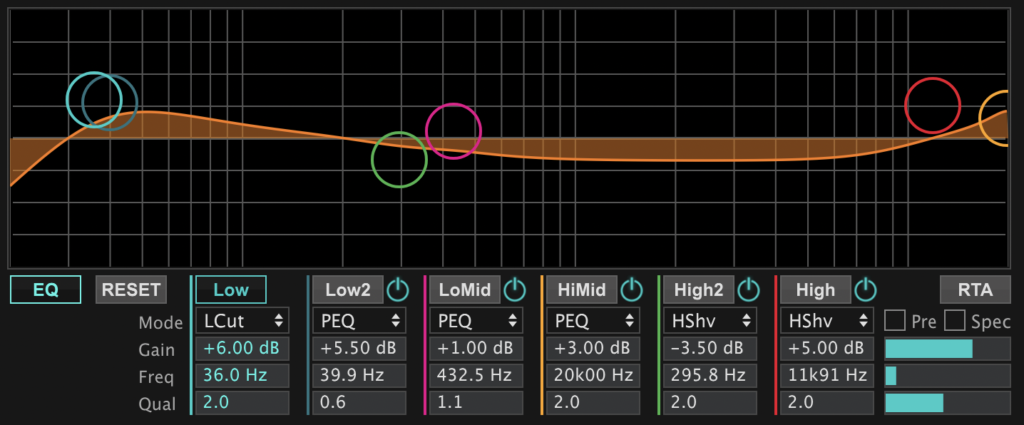
Here is an EQ curve on the Behringer X32 or Midas M32 that I recommend placing on your stream output if you are wanting to replicate your mix in room for those watching at home.
This does a couple things: First, it replicates the Equal-Loudness Curve of 90 Phon to 75 Phon. Additionally, it rolls off the low end at 36Hz, so you will be less likely to clip your outputs. Most listeners at home will not have subwoofers, so they won’t notice a difference.
There are endless tips!
The amount of things you can do to improve your stream audio is a list that is never ending. If you are finding yourself in a bit of a rough patch with your online mix, and are looking for some recommendations or a complete overhaul, consider my 1-on-1 coaching where we can meet virtually and I can help you get through whatever you are facing.
I hope this article was helpful for you and that you took away a few tips and tricks to improve your online stream. If something was particularly helpful, or if you have some more questions for me in a future blog post, drop a comment below! I’m always browsing the comments looking for my next helpful video or blog post. Thanks so much!
